Man In Space
 |
Man In Space was a promotional game issued by the Shell Oil Company in 1969. This was a collect-and-win game with instant winners. With each visit to a participating Shell station, customers received a free aluminum game 'coin' commemorating a U. S. manned space mission. Twenty-six different Man In Space coins were issued. The coins could be mounted on a game card (also free). If all the coins in a section of the game card could be collected, the player won the prize for that section. Prizes included cash in the amounts of $1, $5, $50, $500 and $5,000. Players could also win a beautiful set of bronze space medals which came with a mounting board and an informative booklet about the space missions. If a game coin had INSTANT WINNER on the back, a prize was won without having to collect any other coins. The instant winner prizes were listed on the game card. Glendinning Companies, Inc. produced the game pieces, game prizes, and all the associated promotional materials. Glendinning used their newly-created subsidiary, The Danbury Mint, to strike the medallions and medals. |
The Game Coins
| The game 'coins' (more accurately, 'medallions') were made of aluminum, 26mm in diameter with a reeded edge. They were packaged in plastic capsules with a paper cover. The capsules were designed so the coin hidden inside could be pushed through the paper cover to be removed. |
Below: Plastic capsule containing a game coin. |
 |
|
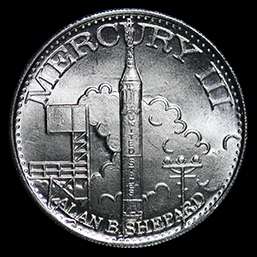 |
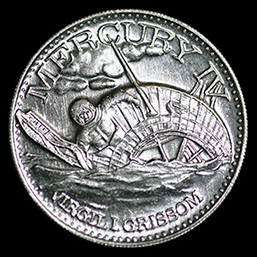 |
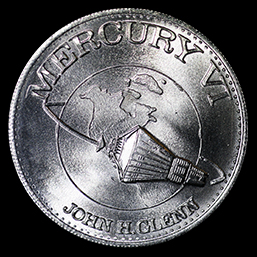 |
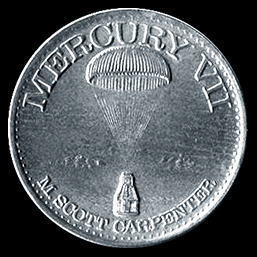 |
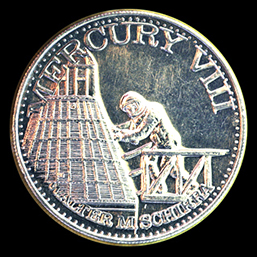
| 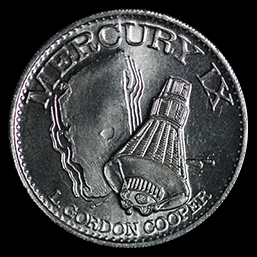
| 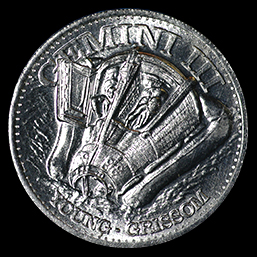
| 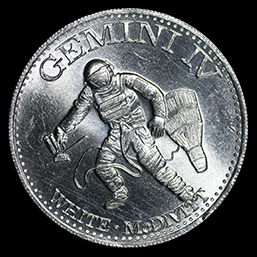 |
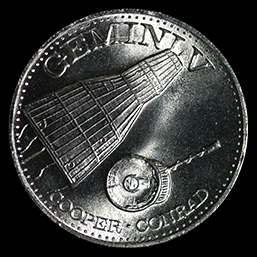
| 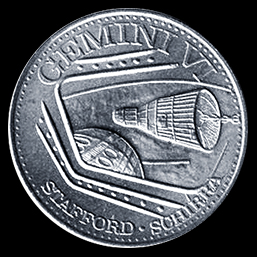
| 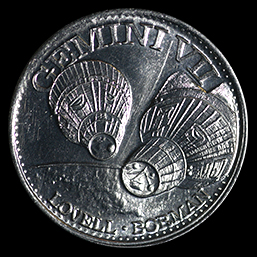
| 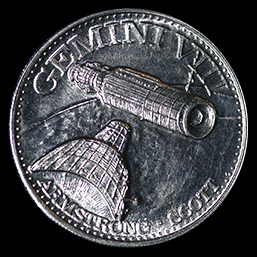 |
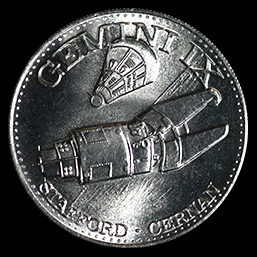
| 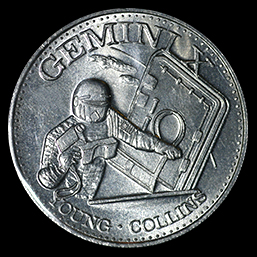
| 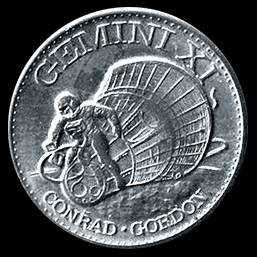
| 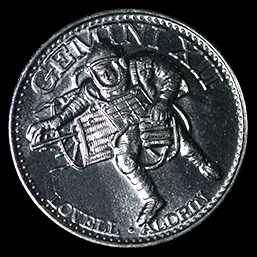 |
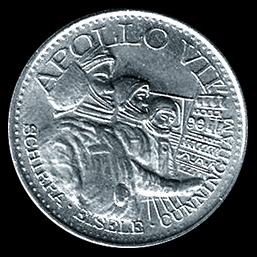
| 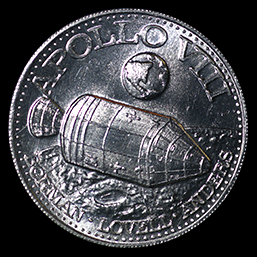
| 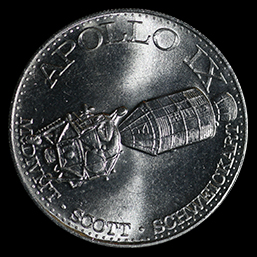
| 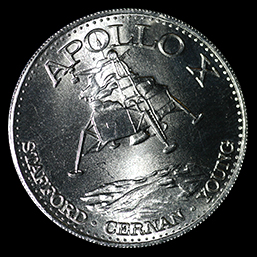 |
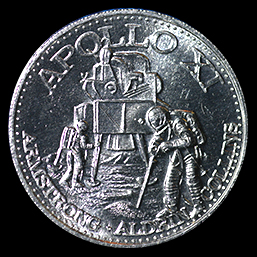 |
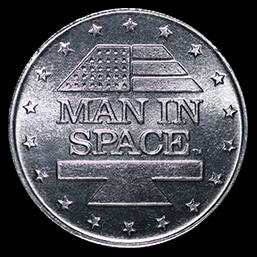 |
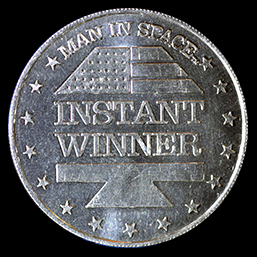 |
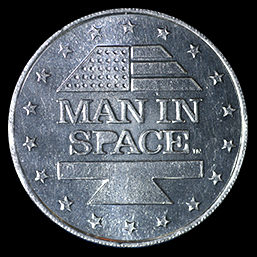 |
There are two varieties of the 'key' coins for each of the six prize sections (except the top prize). This resulted in eleven different 'key' prize-winning coins. Combined with the fifteen common coins, a total of twenty-six different aluminum coins were issued in this game. The following table lists the prize-winning coins.
| Prize | Space Image | Reverse Design |
| $5,000 | Apollo VII | Man In Space (Modified) |
| $500 | Gemini VI | Instant Winner |
| $500 | Gemini VI | Man In Space (Modified) |
| $50 | Gemini XI | Instant Winner |
| $50 | Gemini XI | Man In Space (Modified) |
| $5 | Mercury VII | Instant Winner |
| $5 | Mercury VII | Man In Space (Modified) |
| $1 | Mercury IV | Instant Winner |
| $1 | Mercury IV | Man In Space (Modified) |
| Bronze Medal Set | Mercury VIII | Instant Winner |
| Bronze Medal Set | Mercury VIII | Man In Space (Modified) |
| The game cards are 12 1/8" wide by 8 1/2" tall, printed on card stock, and are die-cut so that the game coins can be mounted and stored on the cards. The cards are also scored in two places (vertically) so that they can be folded. |
Below: Front of a 'Man In Space' game card. No coins are mounted on this card. |
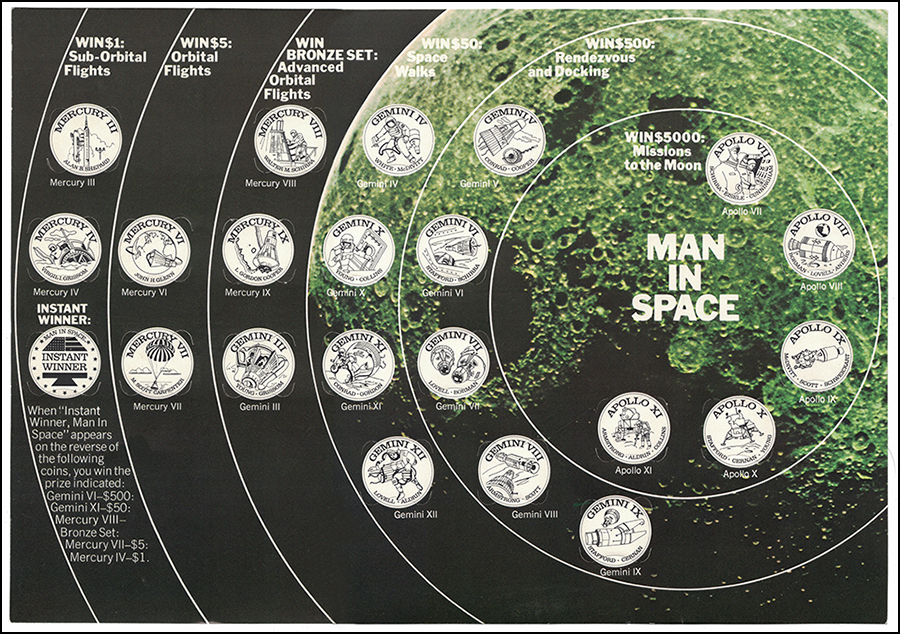 |
Below: Back of a 'Man In Space' game card showing the rules. |
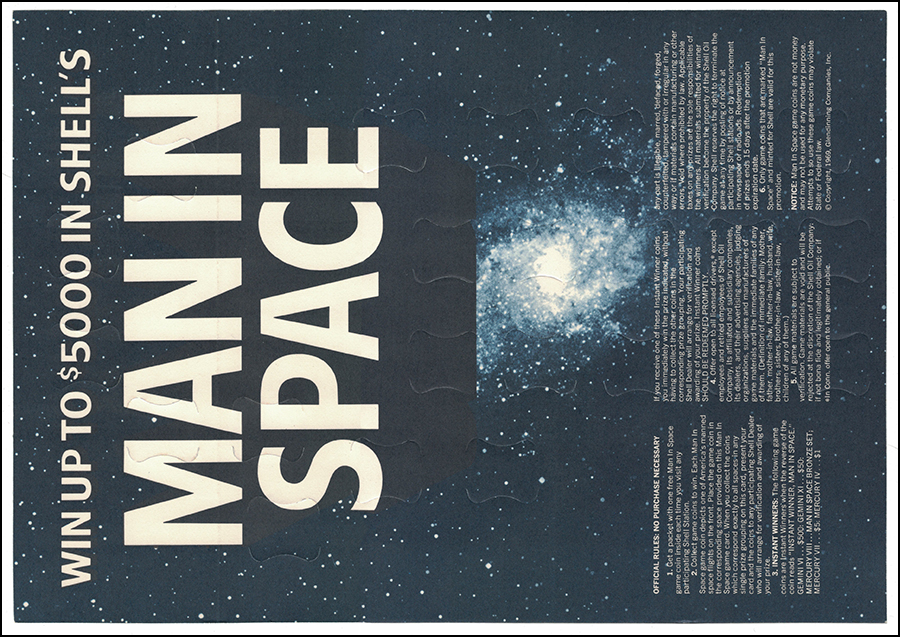 |
| The top prize in the game was $5,000 cash. That was a lot in 1969; enough to buy a new Corvette (or two Chevy Novas)! There were also cash prizes of $500, $50, $5 and $1. In addition to cash, players could win a beautiful set of commemorative space medals struck in bronze. The set came in a large envelope which included the medals, a cardboard mounting board for the medals, and an informative booklet about the space missions depicted on the medals. On the reverse of each medal was a short description of the space mission. There are two versions of this prize. The original version included twenty-one bronze medals. The designs corresponded to the twenty-one obverse designs on the aluminum game coins. In fact, both the bronze medals and the aluminum game coins were struck with the exact same dies. The medals and game coins were struck by The Danbury Mint. On November 24, 1969, Apollo XII successfully completed their moon landing mission and splashed down in the Pacific. The Danbury Mint then created a twenty-second medal commemorating this mission and added it to the set. Therefore, all the bronze prize sets contained twenty-two medals starting in December, 1969. No Apollo XII game coins were struck in aluminum. The components of the bronze prize set are shown below. |
Below: Standard envelope that the bronze prize set was packaged in. The envelopes are 10 1/2" wide by 8 1/2" high. |
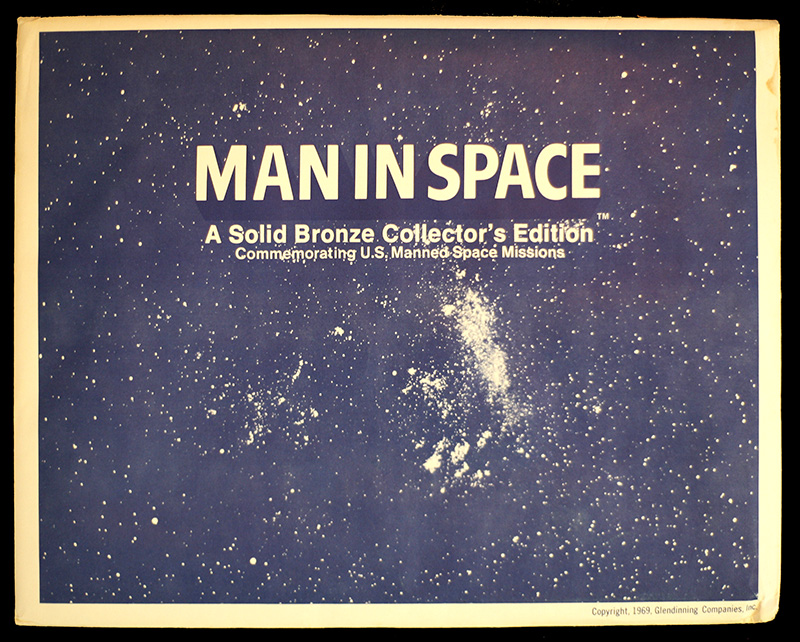 |
Below: Mounting board for the bronze medals. It is made of cardboard and is 10" wide by 8" tall. Shown is the original twenty-one piece version. There are two varieties of the twenty-one piece mounting board; one with small-diameter holes in the white backing layer (shown), and one with large-diameter holes. |
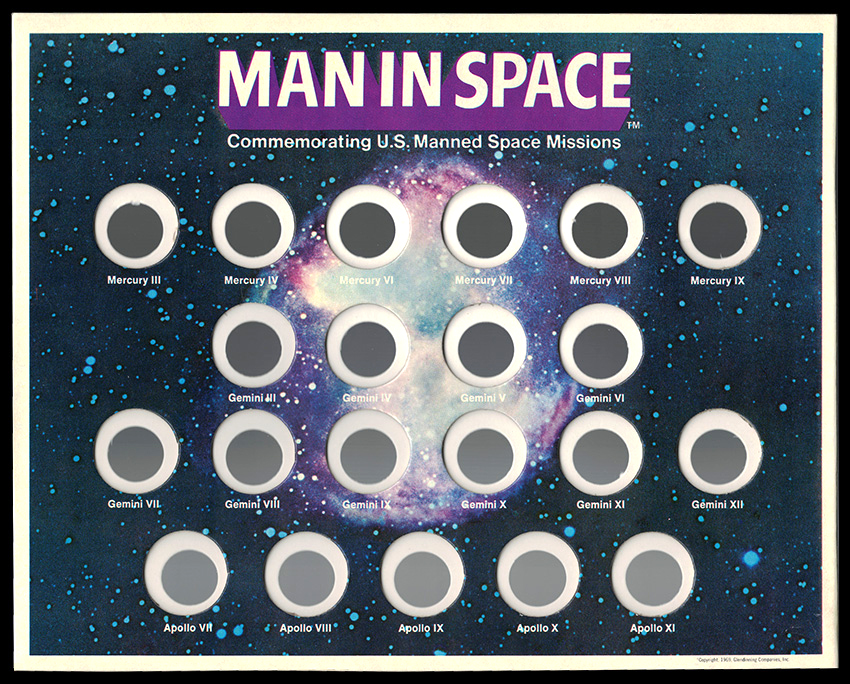 |
Below: This is the twenty-two piece version of the mounting board with a spot for the Apollo XII medal. |
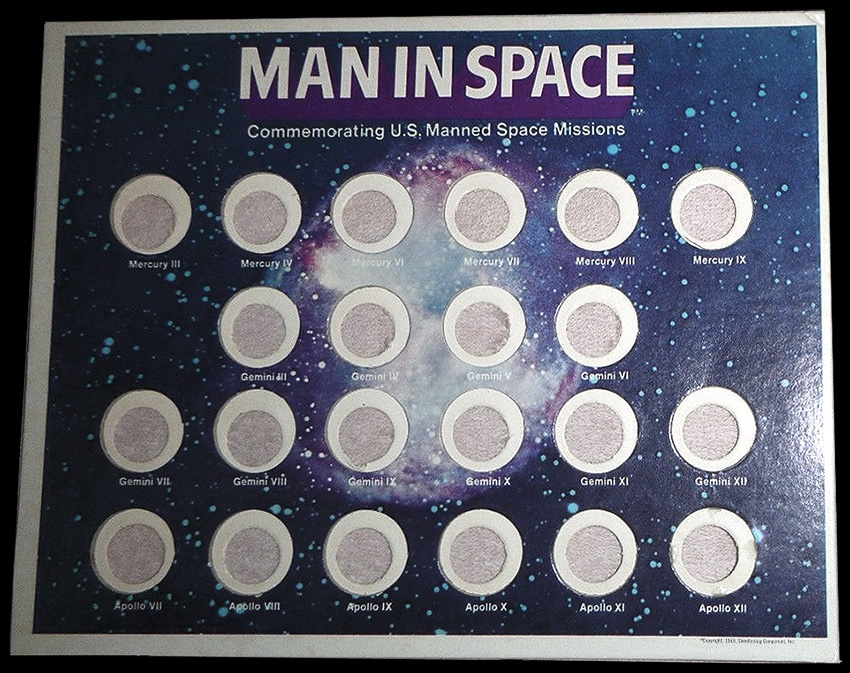 |
Below: The bronze medals that were included with the twenty-one piece set came sealed in a poly bag and, in this case, are still shiny after fifty years. Most medals that were removed from the bag in 1969 now show tarnish, spotting and fingerprints. |
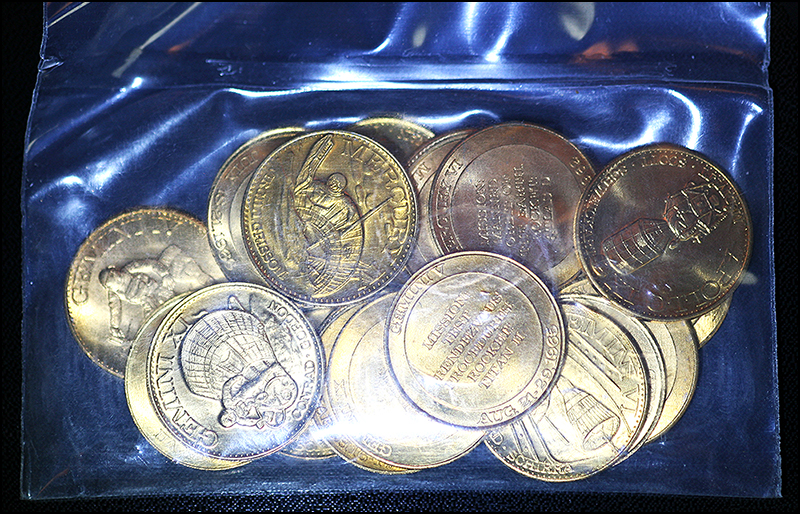 |
Below: The bronze medals that were included with the twenty-two piece set came sealed in a plastic mesh bag. |
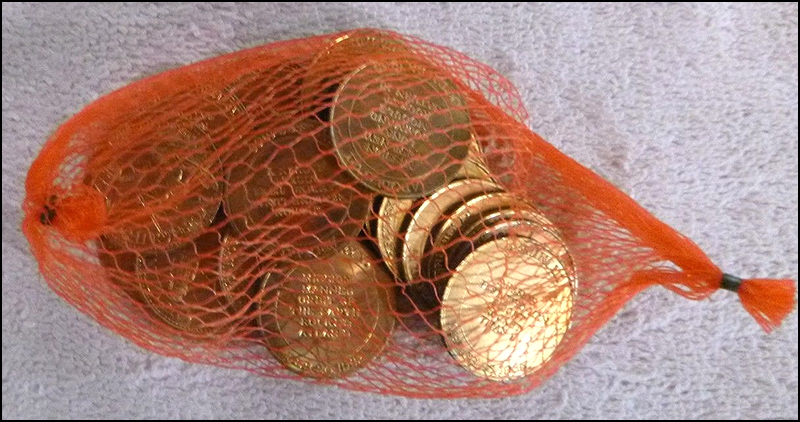 |
Below: The informative booklet included with the bronze medal sets. On page 32, there is a list of manned space missions only up to Apollo XI. |
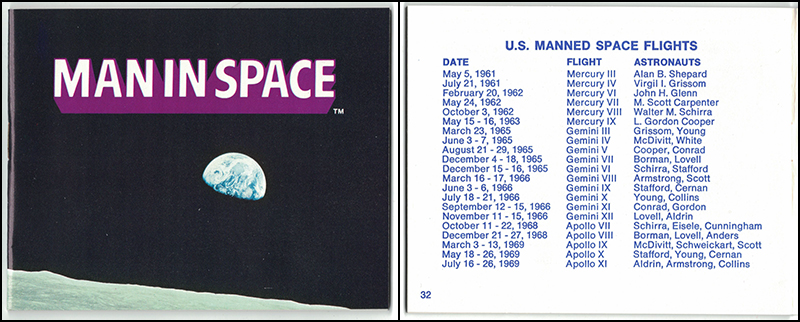 |
| None of the material shown in this section is part of the U. S. version of Shell Oil's Man In Space Coin Game. It is mentioned here because the Man In Space designs were used for various other purposes, including Shell Oil promotions in Europe (and elsewhere), and for retail products produced by The Danbury Mint. The coin shown below is part of a series released in Mexico. I have seen several coins from this series and all the obverse designs are identical ... or nearly identical ... to the U. S. Man In Space series. I have not been able to determine if this was a prize game or just a collectors set. Significantly, the series contains an Apollo XIII coin. That space mission occured in 1970. There is no Apollo XIII coin in the U. S. set because the promotion ended before that space mission. (There is a bronze version of the Apollo XII coin, but no aluminum versions of Apollo XII or Apollo XIII in the U. S. set.) |
Below: Apollo XIII aluminum coin from the Shell Oil 'Man In Space' promotion released in Mexico. |
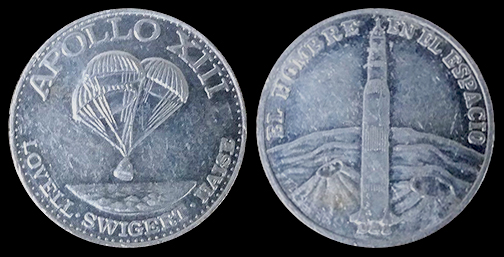 |
| Man In Flight In 1969 Shell Oil launched the 'Man In Flight' promotion in several countries outside the United States. When customers filled their tank at a participating Shell gas station they reveived a packet containing a Man In Flight coin. These coins were part of a collectible set but it was not a game and there were no prizes offered. Shell issued mounting boards for the coins which were designed to inspire their customers to return over and over to try to complete the set. The coin sets commemorated man's acheivements with flight throughout history. Some countries received sets with 20 coins, while other countries received sets with only 16 coins. The 16-coin sets simply had four of the coins intentially omitted. The coins were struck in both bronze and aluminum, and were produced both in round versions and 12-sided versions. This created quite a few varieties. Millions of each variety were produced and they are all fairly easy to find today. |
Below: Two paper packets that contain a Man In Flight collectible coin. |
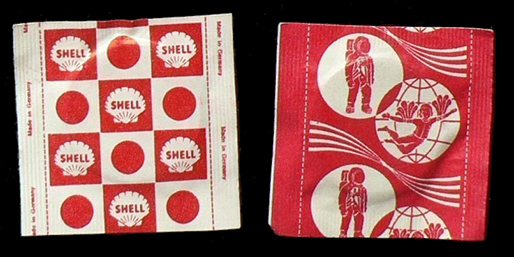 |
Below: Typical round and 12-sided versions of the Man In Flight coins. |
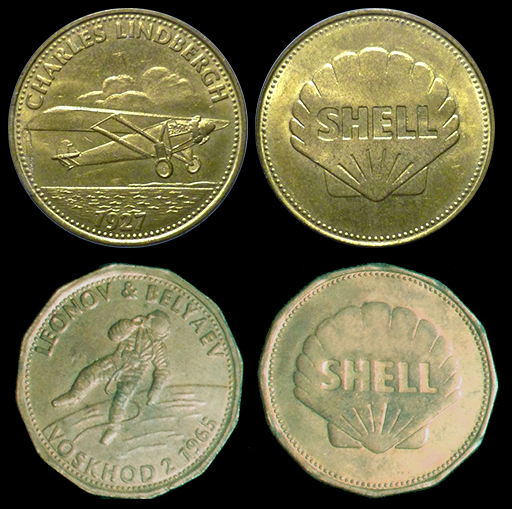 |
| Below: |
Below: Three of the Man In Flight coins commemorate U. S. space missions (Gemini 8, Apollo 8, and Apollo 11). The designs are similar to the Man In Space promotion issued in the United States. This indicates that the coins were produced by The Danbury Mint. |
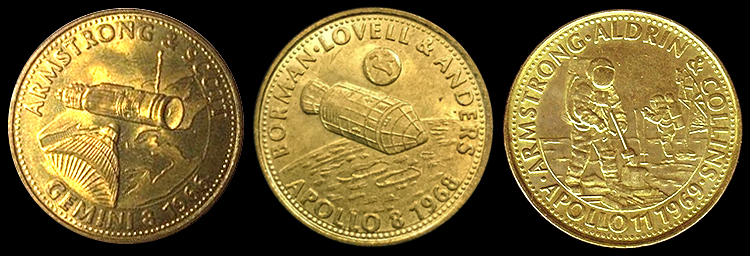 |
** The modified common reverse design (with the 'P' filled in) was to help prevent counterfeiting. The filled-in 'P' is considered a 'secret mark.' Since the obverse of the bronze prize coins were struck with the same dies as the production aluminum coins, it was possible for a counterfeiter to mate, for example, the obverse of a bronze Apollo VII coin with the reverse of a common aluminum coin ... then aluminum-plate the finished coin ... to create a $5,000 prize-winning Apollo VII coin. Such a counterfeit could be easily identified because the 'P' would not be filled in on the reverse. Of course, if a counterfeiter knew about the secret mark, he would use the reverse of an actual prize-winning aluminum coin (say ... a $1.00 winner) to mate with a bronze obverse. Such a coin, after plating, could possibly fool the game officials. I think the creators of the game were banking on the fact that it would take time for cheaters to figure this out, and the game would end before any counterfeit coins would be created. It can be seen in the photo of the Instant Winner reverse design above that the 'P' in 'SPACE' is filled in on that design also. This secret mark was also to help identify a counterfeit coin. If a counterfeiter were to create an Instant Winner reverse die from scratch (based on printed pictures in the promotional material), they would not likely know about this secret mark. |
Click here to return to the main game page. |






